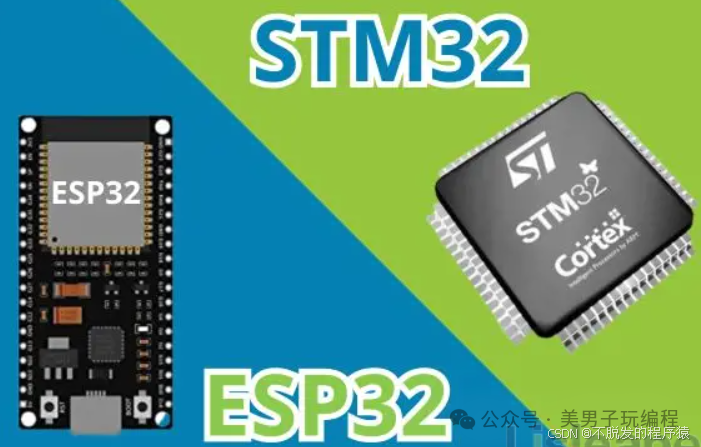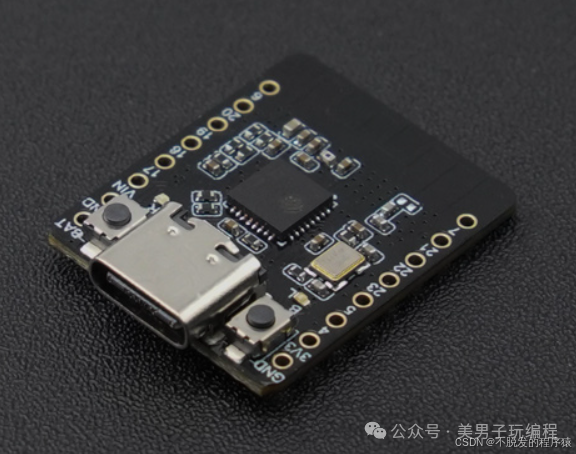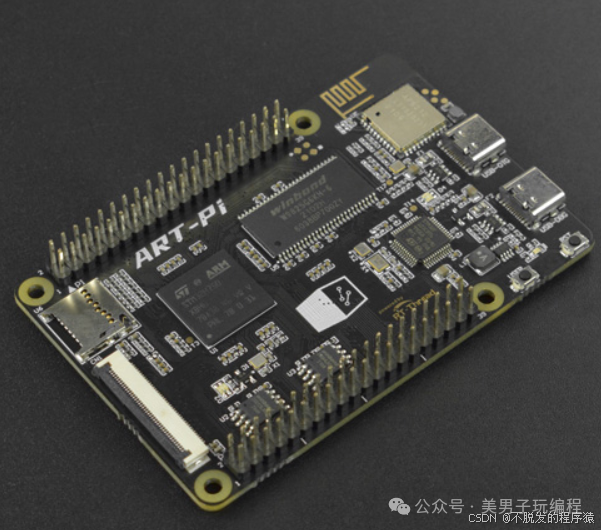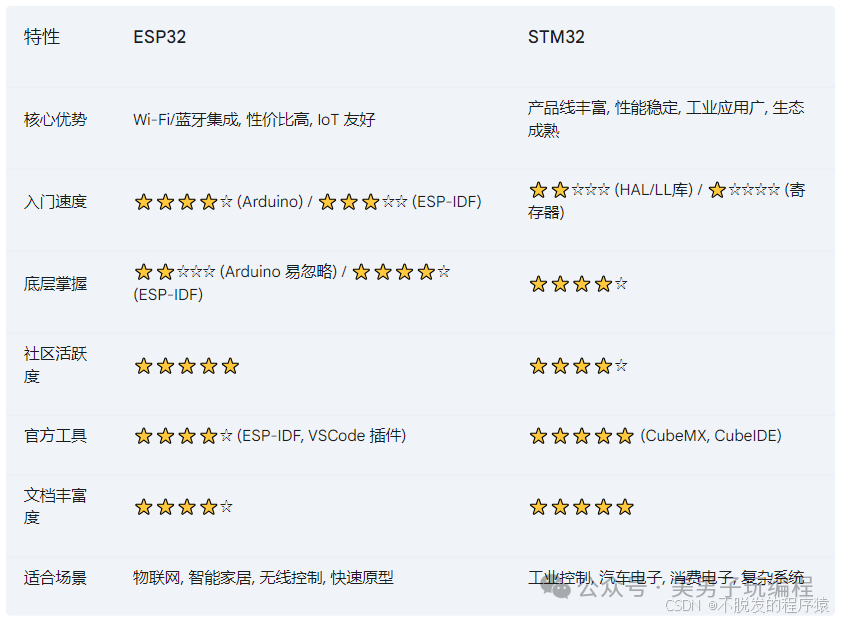
Click the blue text above to follow us
Whether you are a complete beginner or an experienced developer looking to expand your technical stack, the learning curve is definitely an important consideration when choosing a primary MCU.
The ESP32 has rapidly gained popularity 🔥 due to its powerful Wi-Fi and Bluetooth capabilities and active community, while the STM32, with its vast family, stable performance, and wide industrial applications, has long been a staple in the embedded field 🌲.
So, the question arises: who is the best partner on your embedded learning journey?

1
ESP32: The “Internet Celebrity” of the IoT Era
The ESP32 from Espressif is a game-changer, integrating Wi-Fi and Bluetooth functionalities at a very affordable price! This makes it a perfect fit for IoT projects.
Equipped with a dual-core Xtensa LX6 processor (with a clock speed of up to 240MHz), the ESP32’s hardware design is deeply rooted in IoT. It integrates 802.11 b/g/n Wi-Fi and dual-mode Bluetooth 4.2/5.0 communication modules, allowing developers to build wireless connections without external RF components. Its power management unit supports various low-power modes, with current as low as 5μA in deep sleep mode, making it particularly suitable for battery-powered smart devices.

Advantages of Learning ESP32
- Quick to Get Started (Especially with Arduino): If you are familiar with Arduino, congratulations! 🎉 You can quickly start ESP32 development using the Arduino IDE. A wealth of libraries and example codes make it easy to light up LEDs, connect to Wi-Fi, and drive sensors. This “out-of-the-box” experience is extremely friendly for beginners, allowing for quick achievement.
- Strong Ecosystem and Community: Espressif provides the ESP-IDF (Espressif IoT Development Framework), which is powerful and professional, based on FreeRTOS, suitable for in-depth development. The community is very active; whether on GitHub, major tech forums, or the Espressif official forum, you can find a wealth of tutorials, projects, and solutions to problems. Encounter an issue? Someone has likely faced it and shared a solution! 💡
- High Integration, Relatively Simple Peripheral Circuits: Built-in Wi-Fi/Bluetooth means you don’t need to add complex RF modules, simplifying hardware design and debugging complexity.
Challenges You May Encounter When Learning ESP32
- Deep Understanding of ESP-IDF: While Arduino is simple, to fully leverage the ESP32’s capabilities, a deep dive into ESP-IDF is essential. This involves FreeRTOS, network protocol stacks (LWIP), etc., requiring more time and effort.
- Documentation Style: Although the ESP-IDF documentation is comprehensive, sometimes the organization and detail descriptions may require adjustment.
- Encapsulation of Low-Level Details: Sometimes, overly convenient encapsulation can lead you to overlook the underlying hardware principles.
2
STM32: The “Evergreen” of the Industry
The STM32 from STMicroelectronics, based on the ARM Cortex-M core, has an extremely vast product line, covering various application scenarios from low power to high performance. It is a dominant force in industrial control, automotive electronics, consumer electronics, and more.
The STM32 family, based on the ARM Cortex-M series cores, covers the entire product line from M0 to M7. For example, the STM32H7 features a dual-core architecture (Cortex-M7@480MHz + Cortex-M4@240MHz), equipped with 2MB Flash and 1MB SRAM, supporting industrial bus protocols such as Ethernet and CAN-FD. Rich timer resources (advanced control timers, HRTIM) allow precise control of multi-phase motors, with PWM resolution reaching 184ps.

Advantages of Learning STM32
- Strong Systematic Approach, Building a Solid Foundation: Learning STM32 typically starts with register operations or standard peripheral libraries (SPL)/HAL libraries/LL libraries. This process allows you to deeply understand the underlying workings of the MCU, such as GPIO, NVIC, clock systems, DMA, and the configuration and use of various peripherals (Timer, ADC, SPI, I2C, UART, etc.). This foundational knowledge is crucial for any embedded development. 💪 Once you master STM32, other ARM Cortex-M core MCUs will feel much easier.
- Comprehensive Official Toolchain: ST provides a powerful STM32CubeMX graphical configuration tool that can automatically generate initialization code, greatly reducing the complexity of configuring peripherals. The official STM32CubeIDE integrates development, compilation, and debugging functions, providing a unified experience. Of course, Keil MDK and IAR are also commonly used professional IDEs.
- Extremely Rich Documentation and Resources: Data sheets, reference manuals, application notes… ST’s official documentation is very detailed and standardized. Although it requires a lot of reading, it is definitely a treasure. Countless tutorials, books, and video courses are available both domestically and internationally, making learning resources readily accessible.
Challenges You May Encounter When Learning STM32
- Steep Initial Learning Curve: Compared to the ESP32 + Arduino combination, the entry barrier for STM32 is relatively high. You need to understand clock tree configuration, interrupt priorities, and the use of various library functions, which may seem overwhelming at first. 🤯 Directly manipulating registers can deepen understanding but is also more cumbersome and error-prone.
- Diverse and Complex Peripheral Configurations: The powerful features of STM32 peripherals mean many configuration options. For example, a timer has multiple modes and functions, requiring careful reading of the manual to master.
- Networking Functions Require External Components: If your project requires networking, you typically need to connect an external Wi-Fi module (like ESP8266/ESP32) or Ethernet PHY chip, increasing hardware and software complexity.
3
Which is Easier?
Actually, there is no absolute answer to this question; it largely depends on your goals and background.
If you are a complete beginner looking to quickly experience the fun of embedded development and IoT: The ESP32 (with Arduino) is undoubtedly the easier choice. You can quickly get devices online and run interesting applications, gaining a sense of achievement. This is crucial for cultivating interest.
If you want to systematically learn embedded systems and build a solid foundational knowledge for broader embedded development in the future (especially in industrial fields): Starting with STM32 may be a more long-term choice. Although it may be painful at first, mastering the development process and underlying principles of STM32 will provide a more solid technical foundation, making it easier to learn other MCUs later.
If you have a certain foundation in C language and microcontrollers and aim to work on IoT projects: You can directly dive into the ESP-IDF for ESP32. With a certain foundation, learning FreeRTOS and network programming will be relatively smooth, allowing you to fully leverage the ESP32’s performance.
If you are already familiar with STM32 and want to add networking capabilities to your project: Learning ESP32 as a co-processor (via AT commands or SPI/UART communication) or directly transitioning to ESP32 development are both good options. With a background in STM32, learning the peripheral aspects of ESP-IDF will be relatively quick.
Summary in a Diagram:

Regardless of which platform you choose, it is recommended to follow the “T-shaped growth path”:
- Horizontal Expansion: Quickly validate ideas through Hackathons (1-3 months)
- Vertical Deepening: Study chip reference manuals (6-12 months)
- Ecological Integration: Participate in open-source projects and contribute (ongoing)
The limitations of development boards do not lie in the chips themselves, but in the developer’s mastery of system-level thinking.

 Click Read the Original for more exciting content~
Click Read the Original for more exciting content~